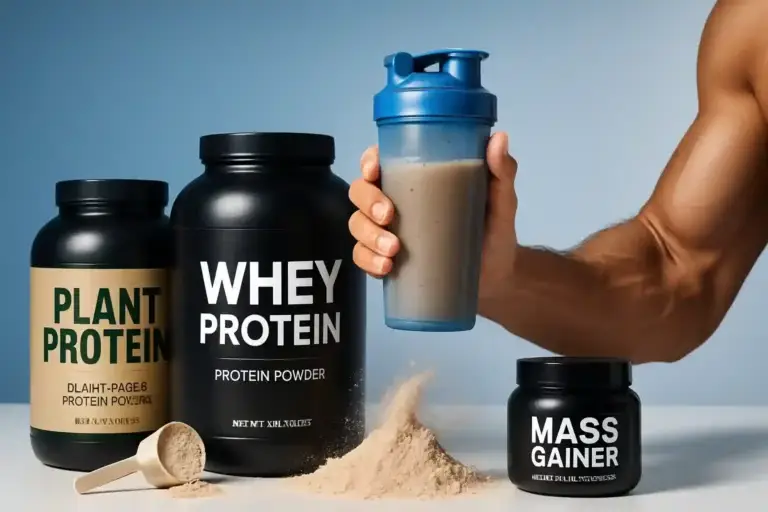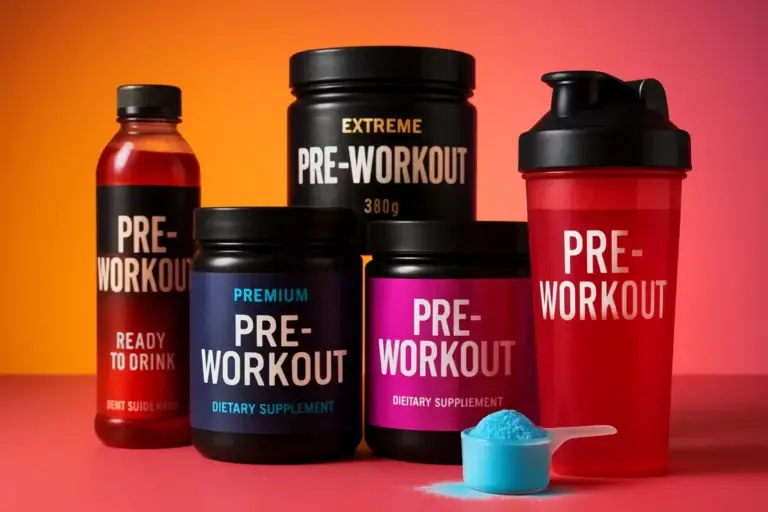Best Workout Routines for Muscle Gain 2025: Science-Backed Training Programs
Compound exercises like deadlifts remain fundamental to the most effective muscle-building routines in 2025
Introduction: The Science of Muscle Growth in 2025
Building muscle effectively requires more than just lifting weights—it demands a strategic approach to training that optimizes the biological processes of hypertrophy. In 2025, our understanding of muscle physiology, recovery dynamics, and training methodology has evolved significantly, leading to more efficient and evidence-based workout routines for muscle gain.
The best workout routines for muscle gain are designed around key scientific principles: progressive overload, appropriate training volume, exercise selection, recovery optimization, and training frequency. Modern research has refined our understanding of these variables, moving beyond the simplistic approaches of the past toward more nuanced, individualized protocols that maximize results while minimizing unnecessary fatigue and injury risk.
This comprehensive guide examines the most effective workout routines for muscle gain in 2025, analyzing various training splits, exercise selections, and programming strategies based on current scientific evidence and real-world application. Whether you’re a beginner looking to build your first significant amount of muscle, an intermediate lifter seeking to break through plateaus, or an advanced trainee optimizing your approach, we’ll provide actionable insights to help you design the optimal training program for your specific goals and circumstances.
The Science of Hypertrophy: 2025 Update
Recent research has refined our understanding of the key mechanisms driving muscle growth:
- Mechanical Tension: Still considered the primary driver of hypertrophy, applying appropriate load to muscles through progressive overload remains fundamental.
- Metabolic Stress: The accumulation of metabolites during resistance training contributes to growth signaling, particularly when training in moderate to high rep ranges.
- Muscle Damage: While once thought to be essential, newer research suggests excessive damage may be counterproductive, with optimal growth occurring with moderate, manageable levels of muscle damage.
- Exercise-Induced Gene Signaling: Emerging research in 2024-2025 has identified specific gene expression patterns that optimize the muscle-building response, suggesting certain exercise protocols may be more effective at triggering these pathways.
Key Factors in Designing Effective Muscle-Building Routines
Before diving into specific workout splits and routines, it’s essential to understand the fundamental variables that determine the effectiveness of any muscle-building program:
Training Volume
Training volume—typically measured as sets per muscle group per week—is a critical factor in hypertrophy. Current research suggests most individuals respond best to approximately 10-20 weekly sets per muscle group, with some variation based on training experience, recovery capacity, and individual response. The best workout routines for muscle gain in 2025 carefully manage volume to provide sufficient stimulus without exceeding recovery capacity.
Training Frequency
Modern research has demonstrated that training muscle groups multiple times per week is generally superior to the once-weekly approach that dominated bodybuilding in previous decades. Higher frequencies allow for more optimal distribution of training volume, potentially enhancing protein synthesis and reducing excessive damage from any single session. Most evidence suggests training each muscle group 2-4 times weekly is optimal for most individuals.
Exercise Selection
While compound movements (exercises that work multiple muscle groups simultaneously) remain the foundation of effective training, a comprehensive approach that includes both compound and isolation exercises provides the most complete stimulus for growth. The best workout routines for muscle gain strategically combine exercises that target muscles from various angles and through different movement patterns.
Progressive Overload
The principle of progressive overload—gradually increasing the demands placed on the body over time—remains the cornerstone of muscle development. This can be achieved through various methods: increasing weight, adding repetitions, incorporating additional sets, reducing rest periods, or improving exercise technique. Effective programs include systematic progression strategies.
Recovery Management
Muscles grow during recovery, not during training itself. The most effective routines balance stimulus with adequate recovery, both within individual workouts (inter-set rest periods) and between training sessions. Deload weeks, strategic deconditioning periods, and autoregulation techniques have become increasingly sophisticated in 2025 programming approaches.
Best Full-Body Workout Routines for Muscle Gain
Full-body training has experienced a significant resurgence in popularity, supported by research showing its effectiveness for both beginners and advanced lifters. These best workout routines for muscle gain train all major muscle groups in each session.
1. 3-Day Full-Body Split
Beginner to Intermediate
This classic approach trains the entire body three times per week, allowing for optimal frequency while providing sufficient recovery between sessions. The 2025 version incorporates modern exercise selection and set/rep schemes based on recent research.
Pros:
- Excellent frequency (3x per week) for each muscle group
- Balanced approach that works well for most individuals
- Time-efficient (3 weekly sessions)
- Ideal for those with limited training availability
- Strong scientific support for effectiveness
Cons:
- Individual sessions can be lengthy
- May not provide sufficient volume for advanced lifters
- Less exercise variety per muscle group in each session
Sample 3-Day Full-Body Routine:
| Day 1 | Day 2 | Day 3 |
|---|---|---|
| Barbell Squat: 3-4 sets × 6-8 reps | Trap Bar Deadlift: 3-4 sets × 6-8 reps | Front Squat: 3 sets × 8-10 reps |
| Bench Press: 3-4 sets × 6-8 reps | Incline Dumbbell Press: 3 sets × 8-10 reps | Weighted Dips: 3 sets × 8-10 reps |
| Barbell Row: 3 sets × 8-10 reps | Pull-Ups: 3 sets × 6-10 reps | Seated Cable Row: 3 sets × 10-12 reps |
| Overhead Press: 3 sets × 8-10 reps | Lateral Raises: 3 sets × 12-15 reps | Arnold Press: 3 sets × 10-12 reps |
| Romanian Deadlift: 3 sets × 8-10 reps | Leg Press: 3 sets × 10-12 reps | Walking Lunges: 3 sets × 12-15 reps |
| Bicep Curls: 3 sets × 10-12 reps | Tricep Pushdowns: 3 sets × 10-12 reps | Hammer Curls: 3 sets × 10-12 reps |
| Plank: 3 sets × 30-60 seconds | Cable Crunches: 3 sets × 12-15 reps | Russian Twists: 3 sets × 15-20 reps |
According to a 2025 meta-analysis published in the Journal of Strength and Conditioning Research: “Three-day full-body training produces comparable hypertrophy to higher frequency splits in most populations, while being particularly effective for those with time constraints or recovery limitations.”
2. 5-Day Full-Body Split
Intermediate to Advanced
This higher-frequency approach has gained significant popularity in 2025, particularly among advanced natural lifters. By distributing volume across five weekly sessions, it allows for shorter, more focused workouts while maximizing muscle protein synthesis opportunities throughout the week.
Pros:
- Maximizes muscle protein synthesis frequency
- Allows for higher total weekly volume with manageable fatigue
- Shorter individual sessions (45-60 minutes)
- Excellent for strength-focused lifters
- Strong emerging research support
Cons:
- Requires 5 days of training commitment
- Demands excellent recovery management
- May be excessive for beginners
Sample 5-Day Full-Body Routine:
This approach uses daily undulating periodization (DUP) with varying intensities throughout the week:
| Day | Focus | Key Exercises | Intensity |
|---|---|---|---|
| Monday | Strength | Squat, Bench Press, Weighted Pull-Ups | Heavy (4-6 reps) |
| Tuesday | Hypertrophy | Romanian Deadlift, Incline Press, Cable Row | Moderate (8-12 reps) |
| Wednesday | Metabolic | Leg Press, Push-Ups, Lat Pulldown | Light (12-15 reps) |
| Thursday | Strength | Deadlift, Overhead Press, Barbell Row | Heavy (4-6 reps) |
| Friday | Hypertrophy | Front Squat, Dips, Pull-Ups | Moderate (8-12 reps) |
Each day includes 2-3 additional isolation exercises for smaller muscle groups, with the total workout typically consisting of 6-8 exercises.
Built With Science’s 2025 analysis states: “The 5-day full-body approach has emerged as potentially the most effective natural muscle-building protocol, particularly for intermediate and advanced lifters. The frequency allows for optimal protein synthesis stimulation while the daily undulating periodization manages fatigue exceptionally well.”
Best Upper/Lower Split Routines for Muscle Gain
Upper/Lower splits divide training into sessions focused on either the upper body (chest, back, shoulders, arms) or lower body (quadriceps, hamstrings, glutes, calves). These best workout routines for muscle gain offer an excellent balance of frequency and volume.
1. 4-Day Upper/Lower Split
Intermediate
The classic 4-day upper/lower split trains each half of the body twice weekly, allowing for significant volume while providing adequate recovery. The 2025 version incorporates modern exercise selection and periodization strategies.
Pros:
- Optimal twice-weekly frequency for each muscle group
- Allows for significant exercise variety
- Manageable session length (60-75 minutes)
- Excellent balance of stimulus and recovery
- Flexible scheduling (can be run as 2-on/1-off or Mon/Tue/Thu/Fri)
Cons:
- Upper body sessions can be lengthy due to numerous muscle groups
- May not provide optimal frequency for advanced lifters
- Requires 4 weekly training sessions
Sample 4-Day Upper/Lower Routine:
| Day 1: Upper (Strength) | Day 2: Lower (Strength) |
|---|---|
| Bench Press: 4 sets × 4-6 reps | Back Squat: 4 sets × 4-6 reps |
| Weighted Pull-Ups: 4 sets × 6-8 reps | Romanian Deadlift: 3 sets × 6-8 reps |
| Overhead Press: 3 sets × 6-8 reps | Leg Press: 3 sets × 8-10 reps |
| Chest-Supported Row: 3 sets × 8-10 reps | Walking Lunges: 3 sets × 10-12 reps |
| Lateral Raises: 3 sets × 12-15 reps | Leg Curls: 3 sets × 10-12 reps |
| Tricep Extensions: 3 sets × 10-12 reps | Standing Calf Raises: 4 sets × 12-15 reps |
| Barbell Curls: 3 sets × 10-12 reps | Weighted Crunches: 3 sets × 12-15 reps |
| Day 3: Upper (Hypertrophy) | Day 4: Lower (Hypertrophy) |
|---|---|
| Incline Dumbbell Press: 4 sets × 8-10 reps | Front Squat: 4 sets × 8-10 reps |
| Lat Pulldown: 4 sets × 10-12 reps | Stiff-Legged Deadlift: 3 sets × 8-10 reps |
| Machine Shoulder Press: 3 sets × 10-12 reps | Hack Squat: 3 sets × 10-12 reps |
| Cable Row: 3 sets × 10-12 reps | Bulgarian Split Squats: 3 sets × 10-12 reps |
| Chest Flyes: 3 sets × 12-15 reps | Seated Leg Curls: 3 sets × 12-15 reps |
| Rope Pushdowns: 3 sets × 12-15 reps | Seated Calf Raises: 4 sets × 15-20 reps |
| Incline Dumbbell Curls: 3 sets × 12-15 reps | Hanging Leg Raises: 3 sets × 12-15 reps |
Muscle & Strength’s 2025 program analysis notes: “The 4-day upper/lower split remains one of the most effective and practical approaches for the majority of lifters. It provides sufficient frequency and volume while being adaptable to various schedules and recovery capacities.”
2. 6-Day Upper/Lower Split
Advanced
This high-frequency variation trains each half of the body three times weekly, making it suitable for advanced lifters with excellent recovery capabilities. The 2025 version incorporates strategic deloading and volume management to prevent overtraining.
Pros:
- Maximizes training frequency (3x weekly per body region)
- Allows for specialized focus in different sessions
- Excellent for advanced lifters needing additional stimulus
- Can produce rapid results during focused training phases
- Supports strength and hypertrophy development simultaneously
Cons:
- Requires 6 weekly training sessions
- Demands excellent recovery capabilities
- Not sustainable long-term for most natural lifters
- Requires careful nutrition and sleep optimization
This approach is typically structured as a push/pull/legs variation with each body part trained three times weekly, using different intensity techniques in each session. Due to the high frequency, volume per session is carefully managed to prevent overtraining.
Renaissance Periodization’s 2025 training guide states: “The 6-day upper/lower approach represents the upper limit of productive training frequency for most advanced natural lifters. While effective during specific mesocycles, it should be cycled with lower frequency periods to prevent systemic fatigue accumulation.”
Best Push/Pull/Legs (PPL) Routines for Muscle Gain
The Push/Pull/Legs split organizes training around movement patterns: pushing movements (chest, shoulders, triceps), pulling movements (back, biceps), and leg training. These best workout routines for muscle gain offer excellent exercise selection and recovery management.
1. 6-Day PPL Split
Intermediate to Advanced
The 6-day PPL has become one of the most popular training splits among serious lifters, training each movement pattern twice weekly while providing focused sessions. The 2025 version incorporates modern exercise selection and intensity techniques.
Pros:
- Optimal twice-weekly frequency for each muscle group
- Focused sessions with excellent mind-muscle connection
- Allows for significant exercise variety
- Manageable session length (60-75 minutes)
- Logical grouping by movement patterns
Cons:
- Requires 6 weekly training sessions
- Less flexible scheduling than some alternatives
- May be excessive volume for some individuals
Sample 6-Day PPL Routine:
| Day 1: Push A | Day 2: Pull A | Day 3: Legs A |
|---|---|---|
| Bench Press: 4 sets × 5-8 reps | Deadlift: 3-4 sets × 5-8 reps | Back Squat: 4 sets × 5-8 reps |
| Overhead Press: 3 sets × 8-10 reps | Weighted Pull-Ups: 3 sets × 6-10 reps | Romanian Deadlift: 3 sets × 8-10 reps |
| Incline Dumbbell Press: 3 sets × 8-12 reps | Barbell Row: 3 sets × 8-10 reps | Leg Press: 3 sets × 10-12 reps |
| Lateral Raises: 3 sets × 12-15 reps | Chest-Supported Row: 3 sets × 10-12 reps | Leg Extensions: 3 sets × 12-15 reps |
| Tricep Pushdowns: 3 sets × 10-12 reps | Face Pulls: 3 sets × 12-15 reps | Leg Curls: 3 sets × 12-15 reps |
| Overhead Tricep Extensions: 3 sets × 10-12 reps | Barbell Curls: 3 sets × 10-12 reps | Standing Calf Raises: 4 sets × 12-15 reps |
| Hammer Curls: 3 sets × 10-12 reps | Cable Crunches: 3 sets × 12-15 reps |
| Day 4: Push B | Day 5: Pull B | Day 6: Legs B |
|---|---|---|
| Incline Bench Press: 4 sets × 6-10 reps | Weighted Pull-Ups: 4 sets × 6-10 reps | Front Squat: 4 sets × 6-10 reps |
| Seated Dumbbell Press: 3 sets × 8-10 reps | Pendlay Row: 3 sets × 6-8 reps | Bulgarian Split Squats: 3 sets × 8-12 reps |
| Dips: 3 sets × 8-12 reps | Lat Pulldown: 3 sets × 10-12 reps | Walking Lunges: 3 sets × 10-12 reps |
| Cable Flyes: 3 sets × 12-15 reps | Seated Cable Row: 3 sets × 10-12 reps | Hack Squat: 3 sets × 10-12 reps |
| Upright Rows: 3 sets × 12-15 reps | Reverse Flyes: 3 sets × 12-15 reps | Seated Leg Curls: 3 sets × 12-15 reps |
| Skull Crushers: 3 sets × 10-12 reps | Incline Dumbbell Curls: 3 sets × 10-12 reps | Seated Calf Raises: 4 sets × 15-20 reps |
| Lateral Raises: 3 sets × 12-15 reps | Cable Curls: 3 sets × 12-15 reps | Hanging Leg Raises: 3 sets × 12-15 reps |
Built With Science’s 2025 analysis states: “The 6-day PPL ranks as ‘Great’ in our workout split hierarchy, offering an excellent balance of frequency, volume, and recovery for intermediate to advanced lifters. The movement pattern organization creates focused, efficient sessions that maximize mind-muscle connection.”
2. 3-Day PPL Split
Beginner to Intermediate
For those with limited training availability, the 3-day PPL trains each movement pattern once weekly but with sufficient volume to stimulate growth. The 2025 version incorporates strategic exercise selection to maximize results despite lower frequency.
Pros:
- Time-efficient (3 weekly sessions)
- Excellent for those with limited availability
- Focused sessions with excellent mind-muscle connection
- Allows for higher volume per session
- Suitable for beginners and those with limited recovery
Cons:
- Suboptimal training frequency (once weekly per movement pattern)
- Longer individual sessions
- May not be ideal for advanced lifters
Sample 3-Day PPL Routine:
| Day 1: Push | Day 2: Pull | Day 3: Legs |
|---|---|---|
| Bench Press: 4 sets × 6-8 reps | Deadlift: 4 sets × 6-8 reps | Back Squat: 4 sets × 6-8 reps |
| Incline Dumbbell Press: 4 sets × 8-10 reps | Pull-Ups or Lat Pulldown: 4 sets × 8-10 reps | Leg Press: 4 sets × 10-12 reps |
| Overhead Press: 4 sets × 8-10 reps | Barbell Row: 4 sets × 8-10 reps | Romanian Deadlift: 4 sets × 8-10 reps |
| Machine Chest Press: 3 sets × 10-12 reps | Seated Cable Row: 3 sets × 10-12 reps | Walking Lunges: 3 sets × 10-12 reps |
| Lateral Raises: 4 sets × 12-15 reps | Face Pulls: 3 sets × 12-15 reps | Leg Extensions: 3 sets × 12-15 reps |
| Tricep Pushdowns: 4 sets × 10-12 reps | Barbell Curls: 4 sets × 10-12 reps | Leg Curls: 3 sets × 12-15 reps |
| Overhead Tricep Extensions: 3 sets × 12-15 reps | Hammer Curls: 3 sets × 10-12 reps | Standing Calf Raises: 4 sets × 12-15 reps |
| Cable Flyes: 3 sets × 12-15 reps | Reverse Flyes: 3 sets × 12-15 reps | Seated Calf Raises: 3 sets × 15-20 reps |
| Dips: 3 sets × 10-12 reps | Preacher Curls: 3 sets × 12-15 reps | Ab Circuit: 3 rounds |
Muscle & Strength’s 2025 program analysis notes: “While not optimal for advanced lifters, the 3-day PPL represents an excellent compromise for those with limited training availability. The higher volume per session partially compensates for the reduced frequency, making it a viable option for consistent progress.”
Best Body Part Split Routines for Muscle Gain
Traditional body part splits (often called “bro splits”) dedicate entire sessions to specific muscle groups. While once considered outdated, modern research has found applications where these best workout routines for muscle gain can be effective when properly designed.
1. 5-Day Body Part Split
Intermediate to Advanced
The modern 5-day body part split has evolved significantly from its predecessors, incorporating strategic exercise selection and volume management based on current research. The 2025 version focuses on maximizing mind-muscle connection and targeted stimulus.
Pros:
- Allows for extreme focus on individual muscle groups
- Excellent mind-muscle connection development
- High volume per muscle group per session
- Psychological benefits of varied training focus
- Shorter individual sessions (45-60 minutes)
Cons:
- Suboptimal training frequency (once weekly per muscle group)
- Less efficient than other splits for most natural lifters
- Requires 5 weekly training sessions
Sample 5-Day Body Part Split:
| Day 1: Chest | Day 2: Back | Day 3: Legs | Day 4: Shoulders | Day 5: Arms |
|---|---|---|---|---|
| Bench Press: 4×6-8 | Deadlift: 4×6-8 | Back Squat: 4×6-8 | Overhead Press: 4×6-8 | Close-Grip Bench: 4×8-10 |
| Incline DB Press: 4×8-10 | Pull-Ups: 4×8-10 | Leg Press: 4×10-12 | Arnold Press: 4×8-10 | Skull Crushers: 4×10-12 |
| Machine Press: 3×10-12 | Barbell Row: 4×8-10 | Romanian Deadlift: 3×8-10 | Lateral Raises: 4×12-15 | Tricep Pushdowns: 3×12-15 |
| Dips: 3×10-12 | Seated Cable Row: 3×10-12 | Leg Extensions: 3×12-15 | Front Raises: 3×12-15 | Overhead Extensions: 3×12-15 |
| Cable Flyes: 3×12-15 | Lat Pulldown: 3×10-12 | Leg Curls: 3×12-15 | Upright Rows: 3×10-12 | Barbell Curls: 4×8-10 |
| Pec Deck: 3×15-20 | Straight-Arm Pulldown: 3×12-15 | Walking Lunges: 3×10-12 | Face Pulls: 3×12-15 | Incline DB Curls: 3×10-12 |
| Shrugs: 4×12-15 | Calf Raises: 5×15-20 | Rear Delt Flyes: 3×12-15 | Hammer Curls: 3×10-12 | |
| Ab Circuit: 3 rounds | Cable Curls: 3×12-15 |
Built With Science’s 2025 analysis states: “While not optimal for most natural lifters from a pure physiological perspective, the 5-day body part split can be effective for certain individuals, particularly those who respond well to high-volume, focused training and have excellent recovery capabilities.”
Comparison of Training Splits for Muscle Gain
When selecting among the best workout routines for muscle gain, consider how different training splits compare across key variables:
| Training Split | Frequency Per Muscle Group | Time Commitment | Session Length | Best For | Scientific Support |
|---|---|---|---|---|---|
| 3-Day Full Body | 3x weekly | 3 days | 60-90 minutes | Beginners, time-constrained | Strong |
| 5-Day Full Body | 5x weekly | 5 days | 45-60 minutes | Advanced, frequency-responders | Strong (emerging) |
| 4-Day Upper/Lower | 2x weekly | 4 days | 60-75 minutes | Intermediate, balanced approach | Strong |
| 6-Day PPL | 2x weekly | 6 days | 60-75 minutes | Intermediate to advanced | Strong |
| 5-Day Body Part | 1x weekly | 5 days | 45-60 minutes | Volume-responders, mind-muscle focus | Moderate |
Research Insight: Training Frequency vs. Volume
A 2025 meta-analysis published in the Journal of Strength and Conditioning Research examined 22 studies comparing different training frequencies while equating for total weekly volume. The findings suggest:
- For beginners: 2-3x weekly frequency per muscle group produced optimal results
- For intermediates: 2-4x weekly frequency showed advantages over 1x weekly approaches
- For advanced: Higher frequencies (3-5x weekly) showed small but significant benefits, particularly when using daily undulating periodization
- Individual response variation was significant, suggesting personalization remains important
The researchers concluded: “While higher frequencies generally produce superior results when volume is equated, individual factors including recovery capacity, training age, and personal preference significantly moderate these effects.”
Optimizing Your Workout Routine for Maximum Muscle Gain
Beyond selecting from the best workout routines for muscle gain, several key strategies can help maximize your results:
Progressive Overload Implementation
Progressive overload remains the fundamental driver of continued progress. In 2025, sophisticated approaches include:
- Double Progression: Increase reps within a target range (e.g., 8-12), then increase weight and drop back to the lower rep target
- Undulating Periodization: Systematically vary intensity and volume within a training week
- RPE-Based Progression: Use Rate of Perceived Exertion to autoregulate training intensity based on daily readiness
- Micro-Loading: Use fractional plates or other methods to make smaller weight jumps when progress slows
- Variable Resistance: Incorporate bands and chains to alter the resistance curve and provide novel stimulus
Exercise Selection Principles
Strategic exercise selection can significantly impact muscle development:
- Exercise Rotation: Periodically rotate between similar exercises (e.g., switching between barbell, dumbbell, and machine presses) to prevent adaptation plateaus
- Range of Motion Emphasis: Prioritize exercises that train muscles through full ranges of motion
- Mechanical Tension Optimization: Select exercises that maximize tension on target muscles throughout the movement
- Weak Point Training: Include exercises specifically targeting lagging muscle groups or portions of the strength curve
- Exercise Sequencing: Arrange exercises to minimize fatigue interference with performance on key movements
Recovery Optimization
Effective recovery strategies are essential for maximizing results from the best workout routines for muscle gain:
- Strategic Deloading: Implement planned reduction in training volume/intensity every 4-8 weeks
- Sleep Prioritization: Aim for 7-9 hours of quality sleep nightly, with consistent sleep/wake times
- Nutrition Timing: Ensure adequate protein intake (1.6-2.2g/kg/day) with strategic distribution around training
- Stress Management: Implement mindfulness practices, as chronic stress significantly impairs recovery
- Active Recovery: Incorporate low-intensity activity between training sessions to promote blood flow and recovery
Personalization Is Key
While this guide presents the best workout routines for muscle gain based on current research, individual response to training varies significantly. The most effective approach involves selecting a scientifically-sound foundation program, then systematically adjusting variables based on your personal response. Track progress meticulously, make one change at a time, and allow sufficient time (typically 4-8 weeks) to evaluate results before making additional modifications.
Conclusion: Building Your Optimal Muscle Gain Program
The best workout routines for muscle gain in 2025 reflect our evolving understanding of exercise science, with greater emphasis on training frequency, strategic volume management, and individualized approaches. While specific programs like the 5-day full-body split, 4-day upper/lower, and 6-day PPL have emerged as particularly effective for many lifters, the optimal routine ultimately depends on your individual circumstances, preferences, and response patterns.
When selecting and implementing a muscle-building program, consider these key takeaways:
- Training frequency of 2-5 times per week per muscle group typically produces superior results compared to once-weekly approaches for most individuals
- Total weekly volume (sets × reps × weight) remains a primary driver of hypertrophy, with most individuals responding best to 10-20 weekly sets per muscle group
- Exercise selection should prioritize compound movements while including targeted isolation work for complete development
- Progressive overload must be systematically implemented through various methods to continue stimulating adaptation
- Recovery management becomes increasingly important as training advancement increases
Remember that consistency with a well-designed program will produce better results than constantly changing approaches. Select a routine that fits your schedule, preferences, and recovery capacity, then commit to it for at least 8-12 weeks while focusing on progressive overload and proper execution.
By combining the scientific principles outlined in this guide with attentive self-monitoring and strategic adjustments, you can optimize your training approach to achieve your muscle-building goals efficiently and sustainably in 2025 and beyond.
References
- Built With Science. (2024, November 24). The BEST Workout Split to Build Muscle (in 2025). Retrieved from https://builtwithscience.com/fitness-tips/best-workout-split-2025/
- Men’s Health UK. (2025, January 22). Use The 6-12-25 Method for Fast Muscle Growth and a Stronger Physique. Retrieved from https://www.menshealth.com/uk/workouts/a44585124/volume-workout-6-12-25-protocol/
- Boostcamp. (2025, January 1). Top 10 Workout Programs to Build Muscle and Strength in the Gym. Retrieved from https://www.boostcamp.app/blogs/top-ten-workout-programs-for-muscle-strength-2025
- Muscle & Strength. (2025). 10 Week Mass Building Program. Retrieved from https://www.muscleandstrength.com/workouts/10-week-mass-building-program.html
- Evangelista, A. L., et al. (2021). Split or full-body workout routine: which is best to increase muscle strength and hypertrophy? Journal of Strength and Conditioning Research. Retrieved from https://pmc.ncbi.nlm.nih.gov/articles/PMC8372753/
- Renaissance Periodization. (2025). Hypertrophy Training Guide. Retrieved from https://renaissanceperiodization.com/hypertrophy-training-guide-central-hub/
- Journal of Strength and Conditioning Research. (2025). Meta-Analysis: Training Frequency for Muscle Hypertrophy. Volume 39, Issue 2.




